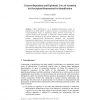102 search results - page 9 / 21 » A cognitive model of spatial path-planning |
CONTEXT
2005
Springer
14 years 1 months ago
2005
Springer
Object identification via a perceptual-demonstrative mode of presentation has been studied in cognitive science as a particularly direct and context-dependent means of identifying ...
AAAI
2007
13 years 10 months ago
2007
How should a robot represent and reason about spatial information when it needs to collaborate effectively with a human? The form of spatial representation that is useful for robo...
EPIA
2009
Springer
13 years 11 months ago
2009
Springer
This paper presents an approach to endow a humanoid robot with the capability of learning new objects and recognizing them in an unstructured environment. New objects are learnt, w...
COSIT
2009
Springer
14 years 5 days ago
2009
Springer
Named urban neighborhoods (localities) are often examples of vague place extents. These are compared with current knowledge of vagueness in concepts and categories within semantic ...
ICMI
2003
Springer
14 years 23 days ago
2003
Springer
Many user interfaces, from graphic design programs to navigation aids in cars, share a virtual space with the user. Such applications are often ideal candidates for speech interfa...


